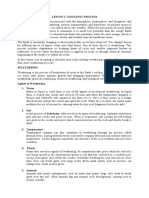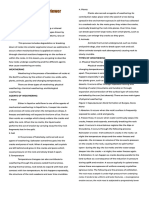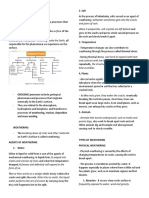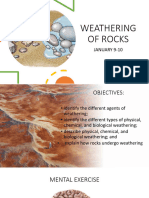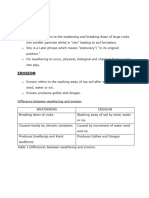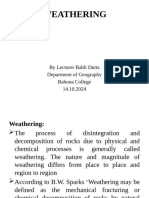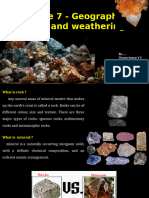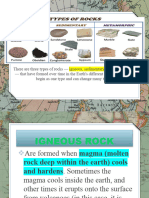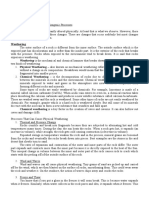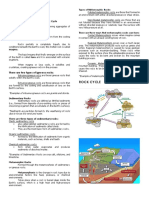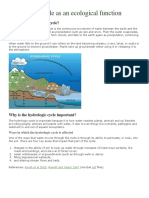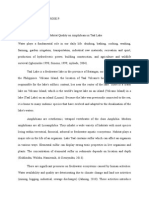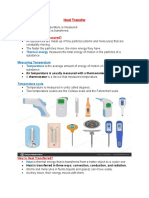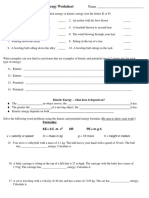0 ratings0% found this document useful (0 votes)
3 viewsEarth Science 11 M1 Quarter 2
Earth Science 11 M1 Quarter 2
Uploaded by
peanutEarth Science Grade 11 (Quarter 2)
Module 1 Notes
Copyright:
© All Rights Reserved
Available Formats
Download as DOCX, PDF, TXT or read online from Scribd
Earth Science 11 M1 Quarter 2
Earth Science 11 M1 Quarter 2
Uploaded by
peanut0 ratings0% found this document useful (0 votes)
3 views3 pagesEarth Science Grade 11 (Quarter 2)
Module 1 Notes
Copyright
© © All Rights Reserved
Available Formats
DOCX, PDF, TXT or read online from Scribd
Share this document
Did you find this document useful?
Is this content inappropriate?
Earth Science Grade 11 (Quarter 2)
Module 1 Notes
Copyright:
© All Rights Reserved
Available Formats
Download as DOCX, PDF, TXT or read online from Scribd
Download as docx, pdf, or txt
0 ratings0% found this document useful (0 votes)
3 views3 pagesEarth Science 11 M1 Quarter 2
Earth Science 11 M1 Quarter 2
Uploaded by
peanutEarth Science Grade 11 (Quarter 2)
Module 1 Notes
Copyright:
© All Rights Reserved
Available Formats
Download as DOCX, PDF, TXT or read online from Scribd
Download as docx, pdf, or txt
You are on page 1of 3
Earth Science for STEM 1.
Water either in liquid or solid
Quarter 2 – form is one of the agents of
Module 1: Weathering mechanical weathering. In liquid form,
it seeped into cracks and crevices of
rocks and when the temperature
Rocks are naturally occurring mass of
dropped, it freezes and definitely will
different kinds of minerals. It can be
expand in the form of ice. The ice then
classified into different kinds such as
works as a wedge which slowly widens
igneous, metamorphic and
the cracks and splits the rock. When
sedimentary rocks. These rocks are
the ice melts, the liquid water
classified based on their composition
performs the act of erosion by
and the process of its formation.
carrying away the tiny rock fragments
Igneous are formed from volcanic
lost in the split.
materials, sedimentary rocks are
result of the cementation of different 2. Salt In the process of haloclasty,
sediments to form a new rock and salts served as an agent of
metamorphic rocks are produced weathering. Saltwater sometimes gets
through exposure of parent rock which into the cracks and pores of rock.
can be an igneous, sedimentary or When it evaporates, salt crystals are
another metamorphic rock to intense left behind and grow in the cracks and
temperature and pressure. pores which caused pressure on the
rock and slowly break it apart.
This scenario proves that rocks are
made up of components that can be 3. Temperature changes can also
broken down overtime. Continuous contribute to weathering through the
exposure to external environmental process called thermal stress. During
forces can separate these thermal stress, rock tend to expand
components. A rock disintegrates or with heat and contract with low
even dissolves because a chemical temperature. As this happens
reaction changes the composition of repeatedly, the structure of the rock
the rock. When certain types of rock weakens and over time crumbles.
come in contact with rainwater, a
chemical reaction occurs, slowly 4. Plants also served as agents of
transforming the rock into substances weathering. Its contribution take place
that dissolve in water. As these when the seed of a tree being spread
substances dissolve, they get washed in the environment sprout in soil that
away. has collected in a cracked rock. As the
roots grow, they widen the cracks,
WEATHERING eventually breaking the rock into
pieces. Over time, trees can break
Weathering is the process of
apart even large rocks. Even small
breakdown of rocks at the Earth’s
plants, such as mosses, can enlarge
surface, by the action of water, ice,
tiny cracks as they grow.
acids, salts, plants, animals, gravity
and changing temperatures. There are 5. Animals that tunnel underground,
three types of weathering: physical such as moles and prairie dogs, also
weathering, chemical weathering, and work to break apart rock and soil.
biological weathering. Other animals dig and trample rock
aboveground, causing rock to slowly
Agents of Weathering
crumble.
3. Exfoliation. It can happen as cracks
develop parallel to the land surface as
a consequence of the reduction in
pressure during uplift and erosion. It
occurs typically in upland areas where
there are exposures of uniform
coarsely crystalline igneous rocks. The
following are the process of
exfoliation.
Types of Weathering
The rock mass at depth is under high
A. Physical weathering is caused by pressure from underlying rocks. It
the effects of changing temperatures tends to be uniform and lack
on rocks, causing the rock to break fractures.
apart. The process is sometimes
assisted by water. It happens → As progressive erosion occurs, the
especially in places where there is rock mass is subjected to
little soil and few plants grow, such as progressively lower pressure of
in mountain regions and hot deserts. overlying rocks which leads to tension
It occurs either through repeated in directions at right angles to the land
melting and freezing of water surface → this tension is relieved by
(mountains and tundra) or through formation of cracks which follow the
expansion and contraction of the land surface. They are relatively flat
surface layer of rocks that are baked on plateaus but can be steep on the
by the sun (hot deserts). There are flanks of mountains which are called
two main types of physical exfoliation domes → once the crack is
weathering: developed; water enters and causes
chemical weathering leading to the
1. Abrasion. It occurs when rocks formation of new low- density
surface is frequently exposed to minerals. This enhances the cracks
water, wind and gravity. and encourages slabs of rock to
detach from the surface.
2. Freeze-thaw. It occurs when water
continually seeps into cracks, freezes B. Chemical Weathering is caused by
and expands, eventually breaking the rainwater reacting with the mineral
rock apart. It occurs in mountainous grains in rocks to form new minerals
regions like the Alps or Snowdonia. It (clays) and soluble salts. These
occurs through the following process: reactions occur particularly when the
water is slightly acidic. These
Rainwater or snow- melt collects in dissolves chemical processes need
cracks in the rocks→ at night the water, and occur more rapidly at
temperature drops and the water higher temperature, so warm, damp
freezes and expands→ the increases in climates are best. Chemical
volume of the ice exerts pressure on weathering (especially hydrolysis and
the cracks in the rock, causing them oxidation) is the first stage in the
to split further open→ during the day production of soils. There are different
the ice melts and the water seeps types of chemical weathering, the
deeper into the cracks → at night, the most important are:
water freezes again.
1. Carbonation – carbon dioxide in the These fragments become more
air in rainwater and becomes weakly exposed to other environmental
acidic. This weak “carbonic acid” can factors that can further enhance their
dissolve limestone as it seeps into weathering. Furthermore, humans
cracks and cavities. Over many years, also indirectly contribute to biological
solution of the rock can form weathering by different activities that
spectacular cave systems. cause rocks to break.
2. Hydrolysis – the breakdown of rock 2. Biological Weathering by Chemical
by acidic water to produce clay and Compounds. Some plants and animals
soluble salts. Hydrolysis takes place also produced acidic substances that
when acid rain reacts with rock- react with the rock and cause its slow
forming minerals such as feldspar to disintegration.
produce clay and salts that are
removed in solution. The only
common rock-forming mineral that is
not affected is quartz, which is a
chemically resistant mineral.
Therefore, quartz and clay are the two
of the most common minerals in
sedimentary rocks.
3. Hydration – a type of chemical
weathering where water reacts
chemically with the rocks, modifying
its chemical structure. Example: H2O
(water) is added to CaSO4 (calcium
sulfate) to create CaSO4 + 2H2O
(calcium sulfate dihydrate). It changes
from anhydrite to gypsum.
4. Oxidation – the breakdown of rock
by oxygen and water, often giving
iron- rich rocks a rusty-colored
weathered surface.
C. Biological weathering of rocks
occurs when rocks are weakened by
different biological agents like plants
and animals. When plant roots grow
through rocks, it creates fracture and
cracks that result eventually to rock
breakage. It can be classified into:
1. Biological Weathering by Physical
Means. Burrowing animals like shrews,
moles and earthworms create holes
on the ground by excavation and
move the rock fragments to the
surface.
You might also like
- GEOL20220 Exercise 5 QsDocument10 pagesGEOL20220 Exercise 5 QsLang Buana 2No ratings yet
- Metamorphic, Igneous and Sedimentary Rocks : Sorting Them Out - Geology for Kids | Children's Earth Sciences BooksFrom EverandMetamorphic, Igneous and Sedimentary Rocks : Sorting Them Out - Geology for Kids | Children's Earth Sciences BooksNo ratings yet
- MFY-01 Brief Procedure (New Pressure Gauge)Document2 pagesMFY-01 Brief Procedure (New Pressure Gauge)mohamadreza13680% (1)
- Disaster Management and Mitigation Question BankDocument6 pagesDisaster Management and Mitigation Question Bankyrajesh1050% (2)
- WEATHERINGDocument3 pagesWEATHERINGZylla Athea TumamposNo ratings yet
- Grade 11 Earth Science ReviewerDocument7 pagesGrade 11 Earth Science ReviewerIssa Belle TusonNo ratings yet
- Earth ScienceDocument8 pagesEarth ScienceRangerbackNo ratings yet
- Lesson 1Document3 pagesLesson 1MJ LontocNo ratings yet
- Earth Science ReviewerDocument22 pagesEarth Science ReviewerPatrick John Delfin BaydoNo ratings yet
- EARTH SCIENCE Q2 Semester 1Document3 pagesEARTH SCIENCE Q2 Semester 1Zhe VenturozoNo ratings yet
- Earthscience Q2 G11Document8 pagesEarthscience Q2 G11jerahmiyah23No ratings yet
- Weathering StudentsDocument32 pagesWeathering Studentsriane6262No ratings yet
- Earth ScienceDocument3 pagesEarth Scienceallan celedonioNo ratings yet
- Q2-W1 WeatheringDocument60 pagesQ2-W1 Weatheringlacaron.kurtalexanderNo ratings yet
- Earth ScienceDocument14 pagesEarth ScienceSan Vicente West Calapan CityNo ratings yet
- Weathering and Erosion, What It Is and Types.Document19 pagesWeathering and Erosion, What It Is and Types.MahirNo ratings yet
- Igneous RockDocument6 pagesIgneous Rocknga khantNo ratings yet
- Lesson 1: Exogenic ProcessesDocument5 pagesLesson 1: Exogenic ProcessesSelene HmpNo ratings yet
- 1.NOTES-WEATHERINGDocument22 pages1.NOTES-WEATHERINGRyan NyamunetsaNo ratings yet
- Earth Science Quarter 2 Module 1Document4 pagesEarth Science Quarter 2 Module 1Rhianne Grace CastroNo ratings yet
- 11- Q2 Earth ScienceDocument2 pages11- Q2 Earth ScienceCJNo ratings yet
- WeatheringDocument17 pagesWeatheringacorbashleyNo ratings yet
- Es 2ND Week1Document12 pagesEs 2ND Week1Isaiah Timothy RabangNo ratings yet
- Natural ResourcesDocument24 pagesNatural ResourcesJane Marry IgnacioNo ratings yet
- WeatheringDocument12 pagesWeatheringachyutchetia0No ratings yet
- Earth Science q2 w1Document15 pagesEarth Science q2 w1Mykhaela Louize GumbanNo ratings yet
- Exogenic ProcessesDocument4 pagesExogenic ProcessesEunice BarcenasNo ratings yet
- Rocks and WeatheringDocument102 pagesRocks and WeatheringeeeyoutbeNo ratings yet
- Earth Science ReviewerDocument9 pagesEarth Science ReviewerRod Raymond EjadaNo ratings yet
- Earth Science by Erna Mae NarcisoDocument3 pagesEarth Science by Erna Mae NarcisoNarciso, Erna Mae B.No ratings yet
- G8 OutlineDocument4 pagesG8 OutlineSHARAINE PRINCESS CASTILLONo ratings yet
- ROCKSDocument40 pagesROCKSAngelica Mae PartosaNo ratings yet
- EsciDocument3 pagesEsciemNo ratings yet
- Exogenic Processes (Grade 11)Document1 pageExogenic Processes (Grade 11)Kristhia Cyra RiveraNo ratings yet
- Concept of Weathering Processe 2Document9 pagesConcept of Weathering Processe 2chikaNo ratings yet
- Exogenic Process EalsDocument4 pagesExogenic Process EalsSamantha EspinoNo ratings yet
- Earth-and-Life-Science-Module 2Document10 pagesEarth-and-Life-Science-Module 2Nagum RhianneNo ratings yet
- Exogeneous Processes and The Rock Cycle: Ii. Lesson ObjectivesDocument9 pagesExogeneous Processes and The Rock Cycle: Ii. Lesson ObjectivesRiguel Jameson AllejeNo ratings yet
- Local Media1662112214919609286Document7 pagesLocal Media1662112214919609286Kimberly Grace guingabNo ratings yet
- Weathering. Form 1-4 Notes Compiled by MR K. Romo 0772858765Document16 pagesWeathering. Form 1-4 Notes Compiled by MR K. Romo 0772858765Sharon MasikiNo ratings yet
- Els Reviewer 2.1 3.5Document7 pagesEls Reviewer 2.1 3.5galidofam36No ratings yet
- HW-1 (Rock Cycle)Document10 pagesHW-1 (Rock Cycle)Tiarra MojelNo ratings yet
- Endogenic and Exogenic ProcessesDocument13 pagesEndogenic and Exogenic ProcessesJohndee Mozart Dela CruzNo ratings yet
- Exogenic ProcessesDocument2 pagesExogenic ProcessesHeart BenchNo ratings yet
- Earth Science: WeatheringDocument2 pagesEarth Science: WeatheringmyuzyizzyNo ratings yet
- WEATHERING AND EROSION: An Exogenic Processes: Eathering Describes The Breaking DownDocument8 pagesWEATHERING AND EROSION: An Exogenic Processes: Eathering Describes The Breaking Downivan pesebreNo ratings yet
- External Earth's ProcessesDocument10 pagesExternal Earth's Processesshannon.tuan02No ratings yet
- Science Chapter 4Document4 pagesScience Chapter 4CazandraShynne RabinoNo ratings yet
- Presentation 25Document139 pagesPresentation 25Bhavamanyu GokulNo ratings yet
- WEATHERING, EROSION AND SOIL Part 1 of 2Document25 pagesWEATHERING, EROSION AND SOIL Part 1 of 2Athanasia HeartfiliaNo ratings yet
- Ns E: Earth Science: There Are Two Types of Igneous RocksDocument4 pagesNs E: Earth Science: There Are Two Types of Igneous RocksMary Joy PalmaNo ratings yet
- Richness Is Not Having Many Possessions. Rather, True Richness Is The Richness of The SoulDocument72 pagesRichness Is Not Having Many Possessions. Rather, True Richness Is The Richness of The SoulMohsin AliNo ratings yet
- Exogenic ProcessDocument4 pagesExogenic Processkhayceemeade2No ratings yet
- G3 Weathering and SoilsDocument22 pagesG3 Weathering and SoilsJJNo ratings yet
- For NTBK Q2 EarthSciDocument11 pagesFor NTBK Q2 EarthSciTrishia Lane GarciaNo ratings yet
- Eal Module 2Document7 pagesEal Module 2Angelina Jolai CentenoNo ratings yet
- Self Learning Module (SLM) : Earth ScienceDocument28 pagesSelf Learning Module (SLM) : Earth ScienceSofia Marie ChenNo ratings yet
- Lesson 1 Weathering of RocksDocument30 pagesLesson 1 Weathering of Rocksjhonalbertolsen0No ratings yet
- Exogenic Processes: Earth Materials and ProcessesDocument41 pagesExogenic Processes: Earth Materials and Processesanon_26027812No ratings yet
- Weathering and Mass Wasting Part 1Document35 pagesWeathering and Mass Wasting Part 1Muhammad AwatifNo ratings yet
- Lesson 4 Geological ProcessesDocument6 pagesLesson 4 Geological ProcessesanghelbongalfaromananguitNo ratings yet
- Earth Science Q2 Week1Document10 pagesEarth Science Q2 Week1MCAPUZ, MARK JOHN, V.No ratings yet
- FMP-102 Lecture 6 & 7 Properties of SteamDocument30 pagesFMP-102 Lecture 6 & 7 Properties of SteamTalha AshrafNo ratings yet
- Baraga Cliff Slope StabilityDocument7 pagesBaraga Cliff Slope StabilityFanteri Aji DharmaNo ratings yet
- An Introduction To Fire Heaters Part 1 PDFDocument7 pagesAn Introduction To Fire Heaters Part 1 PDFoswaldoNo ratings yet
- REFSYS - 3ME-8 (2ND SEM/ A.Y. 2020-2021) Midterm ExaminationDocument3 pagesREFSYS - 3ME-8 (2ND SEM/ A.Y. 2020-2021) Midterm ExaminationRobert GarlandNo ratings yet
- Water Fair JeopardyDocument5 pagesWater Fair Jeopardyapi-251978291No ratings yet
- Mechanics Is The Oldest Physical Science That Deals WithDocument29 pagesMechanics Is The Oldest Physical Science That Deals WithHazem AlmasryNo ratings yet
- Exercise #1 - Physical PropertiesDocument3 pagesExercise #1 - Physical PropertiesVieno Gino CruzNo ratings yet
- Course-Syllabus-Gen Bio 1Document4 pagesCourse-Syllabus-Gen Bio 1Bobby Alguin MorenoNo ratings yet
- PWD PapersDocument11 pagesPWD PapersEknath TaleleNo ratings yet
- Hydro CycleDocument34 pagesHydro CycleCourtney Love Arriedo OridoNo ratings yet
- The Effects of Water and Habitat Quality On Amphibians in TaalDocument4 pagesThe Effects of Water and Habitat Quality On Amphibians in TaalMary Faye ReyesNo ratings yet
- Determination of Bulk Density of Compacted Bituminous Mixture SSDDocument3 pagesDetermination of Bulk Density of Compacted Bituminous Mixture SSDMubashar IslamNo ratings yet
- 11th-Physics Standard Planner-JEEDocument5 pages11th-Physics Standard Planner-JEEMuhammed NehanNo ratings yet
- PE3 NotesDocument4 pagesPE3 NotesKuo SarongNo ratings yet
- Overview of Data Center Energy Use: Bill Tschudi, LBNL Wftschudi@Lbl - GovDocument26 pagesOverview of Data Center Energy Use: Bill Tschudi, LBNL Wftschudi@Lbl - GovSergio GarciaNo ratings yet
- Water2 0Document23 pagesWater2 0aaravparashar97No ratings yet
- Department of Education Perpetual Succour Academy Inc. Pob. Dos .Malabuyoc CebuDocument3 pagesDepartment of Education Perpetual Succour Academy Inc. Pob. Dos .Malabuyoc CebuCry BeroNo ratings yet
- Heat Transfer - G6 Lesson NotesDocument3 pagesHeat Transfer - G6 Lesson NotesJung Ahn HongNo ratings yet
- SDA - Vance Ferrell - The Evolution HandbookDocument144 pagesSDA - Vance Ferrell - The Evolution HandbookMartin Panashe ChirindaNo ratings yet
- Kinetic and Potential Energy WorksheetDocument3 pagesKinetic and Potential Energy Worksheetnayrine shereenNo ratings yet
- 5054 s20 QP 12 PDFDocument16 pages5054 s20 QP 12 PDFJack KowmanNo ratings yet
- Week 01 - Classification and Index Properties of Rocks PDFDocument39 pagesWeek 01 - Classification and Index Properties of Rocks PDFRAJAT PURWARNo ratings yet
- Green House Effect: Biology Investigatory ProjectDocument21 pagesGreen House Effect: Biology Investigatory ProjectLallithambika K63% (8)
- J. Subbiah,: Thermal Power Station-Ii Neyveli Lignite Corporation Limited NeyveliDocument55 pagesJ. Subbiah,: Thermal Power Station-Ii Neyveli Lignite Corporation Limited Neyvelidreamboy87No ratings yet
- GRADE 7 - Course OutlineDocument28 pagesGRADE 7 - Course OutlineTyrone Dave BalitaNo ratings yet
- Topic 1: Net-Zero Community Development For Low Cost PeopleDocument14 pagesTopic 1: Net-Zero Community Development For Low Cost PeoplekarunaNo ratings yet
- VMC Booster Test 5 SolutionsDocument17 pagesVMC Booster Test 5 SolutionsPrince TrickierNo ratings yet







